by Winding Pathways | Jul 14, 2014 | Children/Play, Wonderment
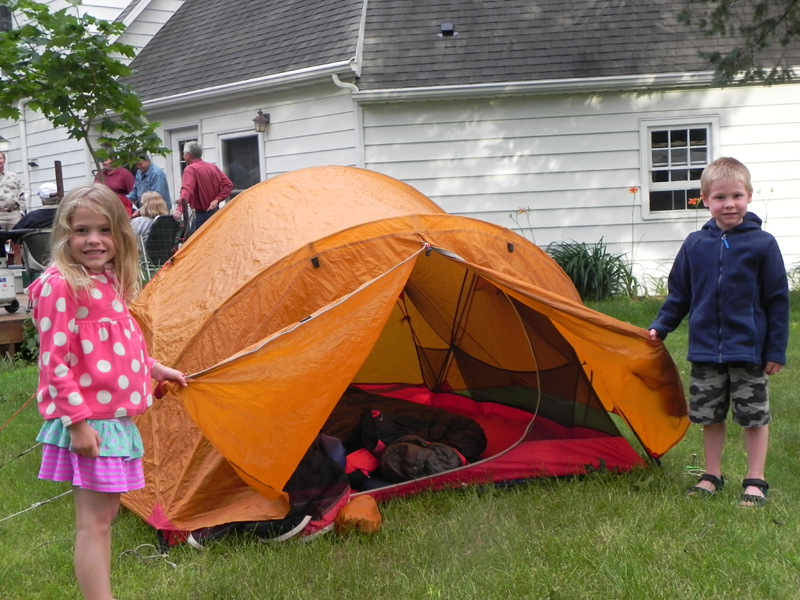
Our son and daughter loved kid camping in the back yard. Warm month Holidays and each summer, usually a week or so before school started, they’d invite a few friends for an overnight adventure.
Today’s well insulated and screened homes keep out frigid temperatures and summer insects. Unfortunately insulation also masks nature’s wondrous late summer sounds.
Children take to camping out. Even a tiny backyard can easily be converted into a temporary campground. Equipment is simple. August weather is warm enough that a sheet and blanket eliminate the need for a sleeping bag. All that’s needed is a simple inexpensive tent, blankets, flashlights, a pillow and some parental guidance.
We won’t forget the night our daughter, then about eight, and her friends came running back into the house after “WHOO WHOO COOKS FOR YOU!” loudly entered their tent from a nearby elm. We went out with a flashlight seeking the elusive, but common, barred owl.
After catching a fleeting glimpse of the bird flying off the girls settled down in the tent to giggle, chat, and maybe even get a little sleep that night.
Here’s what you need to help your child and friends enjoy a night of kid camping right out the back door.
A simple inexpensive tent with a sewed in floor and mosquito netting. Being in a tent gives a feeling of security while keeping out bugs
- Flashlight
- Insect repellent
- Blanket and sheet to ward off evening chilly weather. An inexpensive sleeping bag is better
- Pillow
- Snacks and bottle of drinking water.
- Teddy bear and anything else that gives comfort to a sleeping child
The kids may want to bring a cell phone and games into the tent, although these might distract from listening to the sounds of the yard.
Parents can help make kid camping more entertaining and fun by guiding the kids in simple activities that might include:
FIRE: Gather dry sticks in the yard and neighborhood. Dig a small hole in the yard and build the fire in it. Show the kids how to build a tiny fire. Instruct them in fire safety. Grill hot dogs and marshmallows on sticks gathered from the yard. Enjoy story telling.
STARS: Unfortunately, light pollution and smog limit astronomy in most cities, but the major stars can usually be seen. Help the children find the Big Dipper and North Star. A free phone app helps initially until children are used to searching the night sky.
WALK IN THE DARK: Take a short walk in the dark yard and encourage kids to be comfortable without the pervasive lights of today’s society. Sit for several minutes in the dark yard to let your eyes adjust to night vision. Enjoy the sounds and feel of the evening. You may be surprised how your senses clue you in to the wonders of the night.
ENJOY SOUNDS: August is cricket and cicada month. But lots of creatures call from even the smallest and most urban yard. If lucky owls will call.
Follow up the night’s adventure with breakfast and conversation on what the kids heard and saw on their night outside.
by Winding Pathways | Jul 11, 2024 | Nature, Travel/Columns, Wonderment
Winding Pathways is near the edge of town, making it easy to drive into the country and enjoy rural views. Mostly our car traverses Iowa’s abundant corn and soybean fields, but two recent trips gave exceptional views of different vegetation that bloomed in bright lavender under the June sun.
The Lavender Farm
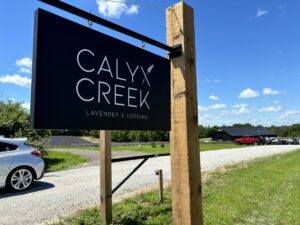
Entry to Calyx Creek
One recent June afternoon as we drove through conventional crops an amazing and delightful view appeared. Shades of purple and stunning white blanketed the undulating land accenting the deep green of cultivated crops. We had discovered Calyx Creek Lavender and Lodging a few miles west of North Liberty, Iowa. Rows of lavender in various stages of growth surrounded us as we entered the main building to find various products made of this unusual plant.
The warm, calming fragrance of the oils of this subtle herb wafted through the shop. Dried bunches hung from racks. Informational signs in front of gleaming machines shared highlights of the distillation process. Soaps, oils, candles, carpet freshener, lavender-infused stuffies and slippers, beverages, and tasty treats beckoned visitors to sample and buy. A lemonade mix was a hit among patrons on this warm summer day. “It smells so good inside, and this lemonade is super!” commented one man, cupping the cool drink in his hands.
-

-
An array of products awaits.
-

-
Slushys are popular.
Tours and Lodging
Part of the experience includes tours, opportunities to harvest and enjoy in your own home, and overnight lodging!
We walked among fields of blooming lavender to two of the several cabins available for rent. The two, built on pedestals, are well-equipped. All the lodgings offer a chance to “get away” while being close to nature. We climbed the stairs, sat on the small cabin’s deck, and took in the rural views of expansive fields of lavender. Peace flowed through us.
-
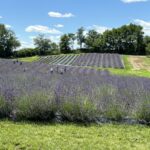
-
Strolling through lavender fields
-
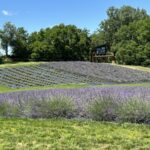
-
Peaceful overnights
Calyx Creek Lavender and Lodging is a fun place to visit, especially during the early summer blooming time. More information at: Calyx Creek LLC, 1722 255th St. NW, Oxford, IA 52322.
Phone: (319) 900-5992
Where Does Lavender Originate?
Lavender is native to the Mediterranean Region of southern Europe and Northern Africa. It has so many uses that it has been planted around the world. It has become problematic in Australia but is a valued product in North America. Lavender has a long, documented, and storied history with applications for improved health, reducing anxiety, moderating the effects of bug bites and burns, and as an antiseptic/anti-inflammatory agent. The latter is useful in the flu season. Gardeners can grow lavender at home. A helpful resource on how to grow it is at Garden Design.
More Rural Views
The fields of lavender at Calyx Creek are carefully groomed, providing a contrast to our discovery the next day. Secondary roads stairstep through Iowa, replete with rural views of corn, beans, oats, cattle, and goats. We were making our way to a reconstructed prairie south of Waterloo, Iowa
The Irvine Prairie
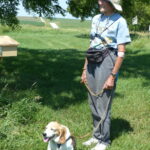
A happy duo.
That day Cathy Irvine led us through her prairie dotted with pale purple coneflowers, purple prairie clover, and blooms of different hues. Common yellowthroats serenaded us as red-winged blackbirds winged around this amazing place.
We admired the beauty of one of Iowa’s largest reconstructed prairies and were humbled to have Cathy Irvine share part of her day with us. Some people are so inspiring. She’s one.
After years of conventional farming, her vision took her land in a different direction. She’d turn the clock back and restore her land to how it looked and functioned before the first plow turned the original prairie into row crops. She didn’t do this on a whim. For decades Cathy had thought about, researched, attended programs on, and connected with experts on prairies. She knew that reconstructing the native habitat with its diverse plants and animals was right to do.
-
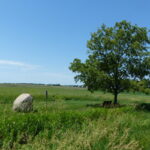
-
Glacial boulders are part of the landscape.
-
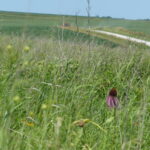
-
Contrast
Collaboration
Working with the Iowa Natural Heritage Foundation and the University of Northern Iowa Tallgrass Prairie Center she placed much of her farm in conservation easement and collaborated on restoring it to its native vegetation in honor of her late husband, David. Being in a conservation easement means that it will remain a wild and gorgeous prairie forever, no matter who might own the land in the future.
Iowa’s Rich Heritage
Iowa’s original prairie hosted upwards of 300 plant species on each acre that agriculture transformed into vast monocultures of soybeans and corn. Cathy’s land was in row crops until she decided to give her property to the Tallgrass Prairie Center under a conservation easement. Starting in 2018 the Prairie Center began planting upwards of 100 native species an acre and followed it up with prescribed burning, weeding, and even plugging in more native species.
Cathy, the Tallgrass Prairie Center, and the Iowa Natural Heritage Foundation welcome visitors to experience what much of Iowa once looked like. It’s a place to enjoy dancing prairie grasses and forbs on a breezy summer day, listen to birds trilling across the expanse, watch butterflies forage on blooms, and be inspired by the quiet beauty resulting from a transformation springing from Cathy’s vision and cooperative effort.
The Prairie is located at 1173 55th Street, Dysart, Iowa. Several mowed trails radiate outward from a small parking lot. A bench nestled under a spreading tree offers shade and a place to reflect.
-
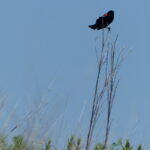
-
Calling out territory
-
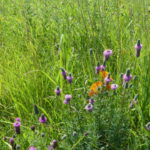
-
colorful forbs
-
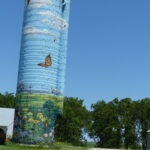
-
Colorful silo
Best Times To Enjoy Prairie Flowers
Prairie flowers bloom throughout the growing season but during midsummer’s heat, the colors are most amazing. However, the prairie is magical in any season. We enjoy our small reconstructed prairies through all seasons and especially in the summer months.
The Lavender Farm meticulously cultivates a useful plant not native to Iowa and the Irvine Prairie carefully stewards a rewilded prairie. Both are gorgeous.
For more information, visit the Tallgrass Prairie Center and the Iowa Natural Heritage Foundation websites.
The Color Purple
Our eyes had the good fortune to view purple lavender one day and purple prairie flowers the next, but purple is a tricky color, at least for some people. Like around 10% of men and boys, Rich isn’t able to see it or see it as folks with normal color vision can. “Red and shades of red are hard for me to see. Purple is nearly impossible. It seems odd but I can see the color but know it looks very different to me than to most folks. If someone asks me what purple looks like I have to say, I’m not sure since I can’t really see it,” he said. “Fortunately I can see blue and yellow prairie blooms and magnificent butterfly milkweed flowers that seem to glow a bright orange,” he added.
Winding Pathways encourages readers to take in any of their native habitat to appreciate our green island home – Earth.
by Winding Pathways | Apr 25, 2024 | Nature, Reflections/Profiles, Travel/Columns
The steep climb got us huffing and puffing until we crested the hill and looked around. Beneath us was a spacious pond and on the far hillside cattle grazed in the evening’s dwindling light. Oncoming darkness, combined with tired leg muscles, encouraged us to circle back to the historic farmhouse where we overnighted.
It sounds like a Montana adventure, perhaps at the spacious American Prairie, but it isn’t. We were at Iowa’s Whiterock Conservancy, a remarkable landscape just south of the tiny town of Coon Rapids in the west central part of Iowa.
What IS Whiterock Conservancy?
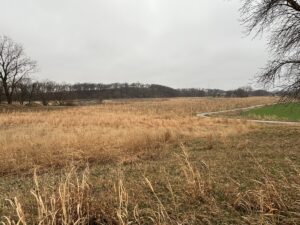
Bike or hike or ride your way along miles of intriguing trails.
Whitrock defies the norm in a state short on places big enough for outdoor enthusiasts who love spaciousness. Winding through its 5,500 acres are about 40 miles of trails that welcome hikers, mountain bikers, equestrians or folks just wishing to walk away from the noise and distractions of modern life. Whiterock is a place to enjoy the quiet and the dark sky of this lightly settled region.
There’s more. Whiterock Conservancy, named for an outcropping rising above a campground, is a testament to the formation of modern agriculture. Roswell Garst farmed the land and enthusiastically promoted hybrid corn. He was a force enabling the land to dramatically increase its production of food.
Entrepreneur, Ambassador, Visionaries
Garst was also an ambassador of sorts and invited his friend, Soviet Premier Nikita Khrushchev, to visit in 1959. The Russian was eager to find ways to expand his country’s food production. For a day the world came to the Garst Farm and Coon Rapids, Iowa. Dignitaries, reporters, and even some possible Soviet Spies were everywhere. The story is that one could tell the “spies” because, in this decidedly farm community, they were the only ones dressed in suits.
The Garst Family was visionary. Rather than sell their land for massive modern agriculture they encouraged the development of the land trust that combines agriculture and outdoor recreation in creative mosaics.
What’s There
After our walk and a picnic dinner, we settled down for the night in the old Garst Farmhouse, marveling at the collection of books, vintage furniture, and artifacts from Khrushchev’s visit inside. Its style was reminiscent of old-time New England homes – low ceilings, a newell post at the end of the stairs, wainscotting, tiled bathrooms, wallpapered ceilings, drapery on the windows, period cookware, and elegant teacups nestled in a corner cupboard. A swing-through door led to the well-equipped kitchen that looked out over a play yard and firepit. We could almost hear Roswell Garst talking up hybrid corn.
How It Came About
The Whiterock Conservancy was created as a nonprofit land trust about 20 years ago. Today it’s a progressive, innovative, and fascinating organization that combines agriculture, ecological restoration, lodging, and outdoor recreation spread over more than 5,000 acres.
We watched the cattle graze, listened as a flock of goats “baaahed” in anticipation of their dinner, drove miles of gravel roads through the property, and walked several trails. Perhaps our favorite was admiring the winter worn prairie grasses and forbs still standing sturdily in a brisk spring wind that rippled the pond’s water.
Things To Do at Whiterock Conservancy
Our short visit just whetted our appetite for the outdoors, and we plan to return. Here are some of many activities welcomed on the land:
-
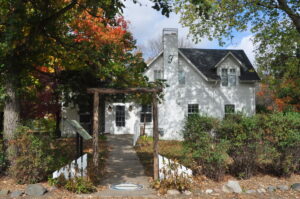
-
Period style farmstead that greeted Nikita Khrushchev. Photo Credit Whiterock Conservancy.
-
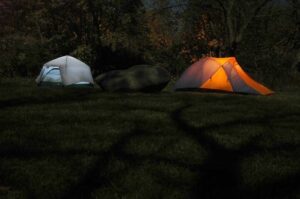
-
Tenting along the river. Photo credit Whiterock Conservancy.
-
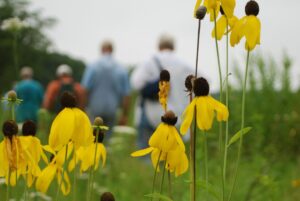
-
The Conservancy hosts a variety of programs. Photo credit Whiterock Conservancy
Camping: Several smallish and rather rustic campgrounds invite overnighters seeking quiet and gorgeous star viewing.
Trails: Well planned and maintained trails wind through hills, prairies, wetlands, and ravines. Hikers, equestrians, and mountain bikers are all welcome.
Home and cabins: Several indoor lodging options range from staying in one of many rooms in the historic farmhouse, to a nearby cottage. There’s even a walk-in cabin.
Activities: Staff and volunteers sponsor periodic programs to help visitors enjoy and appreciate nature and the Conservancy.
Fishing and Hunting: Visitors bearing an Iowa fishing license are welcome to try catching dinner from a dozen ponds scattered about the land. Check with headquarters about bowhunting.
Learn More and Visit!
The Whiterock Conservancy is a nonprofit land trust, funded by donations and grants. A list of fees and information is posted on their website. Donations are suggested for trail users and can be put in convenient boxes near trailheads. We so enjoyed the stay and visit with the staff.
by Winding Pathways | Jul 13, 2023 | Gazette Features, Travel/Columns
What is a Pilgrimage?
From: University of York: “‘Pilgrim’ and ‘pilgrimage’ are words that have carried a range of meanings over the centuries.
“The English term ‘pilgrim’ originally comes from the Latin word peregrinus (per, through + ager, field, country, land), which means a foreigner, a stranger, someone on a journey,…. It can describe a traveller making a brief journey to a particular place….”
Our Context
We consider travel a “pilgrimage.” The destination is not the sole purpose. We enrich our souls by being open to amazing travel surprises. Here are some we discovered on recent trips to New Jersey and Saskatchewan, Canada.
Interstate Highways are outstanding for getting places quickly, but we consider them a boring slog that bypasses fascinating places. Too many people focus on getting to a destination and miss intriguing sites along the way. In contrast, we often scan maps and brochures and, from time to time, duck off Interstates to drive on somewhat parallel, smaller roads stopping in towns bypassed by the interstates.
Two trips from this summer that highlight this concept come to mind. We’ve featured the Hopewell Earthworks around Chillicothe, OH, and took in great southern BBQ at Old Canal Smokehouse. The server presented us with an enormous slice of peanut butter pie and regaled us with tales of his childhood exploring the steep mounds and snaking earthworks while four of us made quick work of the dessert.
Easterly

An unusual cafe.
On our return from the East Coast, we needed a respite from the truck traffic and fast driving of I-80, so we exited and drove through Brookville, PA. Seeking coffee, we discovered the Calico Cafe. While ordering we asked the barista where the restrooms were. She responded, “You’ll find them through the cat room behind me.” Cat room!!!!! Well, we opened the door to find people petting cats. It was a place for them to get their cat fix. We’re not cat people but the experience was different……something that can’t be found in chain eateries along Interstate exits. And the coffee was decent.
Westerly
On a more recent drive to Saskatchewan, Canada, we were cruising north on Interstate 29 in North Dakota and spotted a tiny note on the map showing the location of North America’s tallest structure. It was along a small paved road that headed in the direction we wanted to go, so we exited, made a few turns, and saw, not a massive skyscraper, but a 2063-foot-tall television tower. To stabilize the tower, guy wires extended scores of yards out. Not terribly exciting but a sight we’d have missed had we stayed on the interstate. And it has a history.
Just north of the tower we passed through the small town of Mayville, North Dakota, and discovered a gem of a college called Mayville State University. With 80+ majors/minors, a student/faculty ratio of 14:1, and reasonable tuition, MSU would be a good bet for a solid education and a bright, “no-debt” future. Only a few miles north we tented overnight in Turtle River State Park. Songbirds serenaded us in the evening and greeted us in the early morning.
Medicine Wheel and College Towns
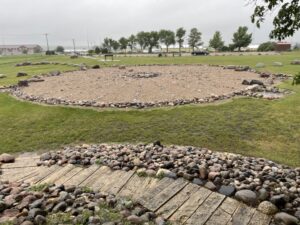
Glacial boulders align to the rising and setting sun and moon.
On our return trip we were eastbound on Interstate 94. We’d picked up a brochure at a North Dakota welcome station about the Medicine Wheel Park in Valley City, a town between Bismarck and Fargo. Even though it was raining we exited, donned raincoats, and walked around a fascinating and well-maintained medicine wheel almost adjacent to the big road. The structure, inspired by the Big Horn Medicine Wheel, marks the rises and sets of the sun and moon in relation to the Earth. Then we drove through Valley City State University before jumping back on the big road. VCSU has an interactive financial program with surrounding states and two Canadian provinces. Recreational opportunities abound.
Our western trip passed the geographic center of North America in Rugby, ND, (watch the video! It’s rather fun!), and a Continental Divide (Laurentian) between water flowing to Hudson Bay and that flowing to the Gulf of Mexico. Actually, a map reveals several watershed divides in the Americas.
Most travelers would have buzzed by these interesting stops. Curiosity grips us and leads us to unusual places we’d usually never heard of. We are richer for this.
Great Plains Colleges
Our son, Daniel, graduated from a college few people have ever heard of – Black Hills State University in Spearfish, South Dakota. It was an outstanding educational experience for him. And, tuition and living expenses were modest. He graduated debt free.
We’ve explored other colleges in small Great Plains towns, sometimes to have coffee in their student center, and to learn about them. Many, like Black Hills State, are little known, offer outstanding education, and are inexpensive. They offer students the chance to earn a college degree without debt.
Here are a few we’ve visited:
Black Hills State, Spearfish, South Dakota.
Valley City State University, Valley City, North Dakota
Mayville State University, Mayville, ND
Wayne State University, Wayne, Nebraska
Know someone considering college? One of these rather obscure but top-notch schools might be a perfect match……and there are many more we’ve yet to visit.
by Winding Pathways | Dec 15, 2022 | Birds, Garden/Yard, Nature

A chickadee gently cradled in man’s hand.
On an early, warm, bright November day, several Coe and Mt. Mercy University Students with their professors arrived at Winding Pathways to band birds. They stood mesmerized as one cradled a diminutive bird in his hand. This long-distance traveler had met a temporary misfortune.
It was a golden-crowned kinglet, a tiny bird tipping the scales at only .19 ounce. On a recent night, it had winged south from its summer home in the north and decided to rest and feed amid the tall grass and woods at Winding Pathways. Then, it would continue southward. It didn’t know that Dr. Neil Bernstein had other plans.
-
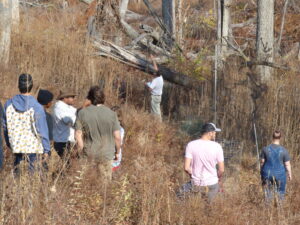
-
Dr. Bernstein sets a mist net by a fallen log.
-
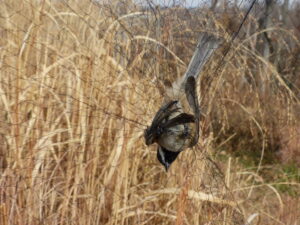
-
trapped chickadee
-
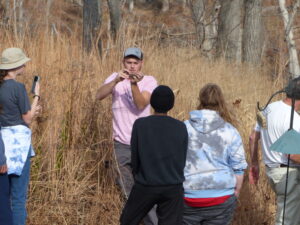
-
Untangling bird
Neil had stretched mist nets an hour earlier. The kinglet, along with chickadees and a Carolina wren didn’t see these fine mesh nets in time. They were caught but uninjured. Neil showed the students how to band birds by gently removing them from the net, weighing each tiny bird, recording data, placing a small lightweight band around its leg, and releasing it. Data are then submitted to help researchers better understand bird migration.
The kinglet and wren waited patiently as students weighed and banded each, but not the chickadees. These bitty, year-round residents have an attitude. They didn’t like being held one bit and pecked at the student’s fingers.
-
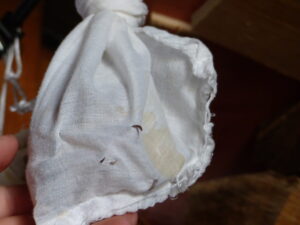
-
A bird’s claws poke through the bag.
-
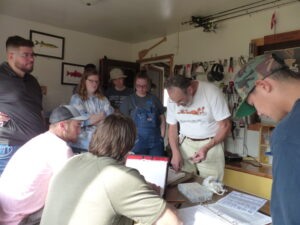
-
Verifying information is important.
-

-
Tiny band ready to attach to a bird
-
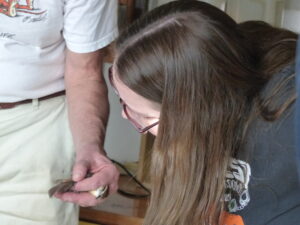
-
Checking feathers
Student Reactions
Students were used to collecting scientific data on different natural topics. They were fascinated by the process of banding birds. “I thought we were going to listen to a bird band!” joked one student. Another envisioned running around chasing birds, concluding that would not work well.
Students commented on how the pecks were sharp but not worrisome. One explained she talked quietly to the chickadee as she carefully held it. Reassuring the bird, she would not hurt it. “I could feel its heart rate slow down,” she commented.
Although chickadees are small, kinglets are even smaller. This kinglet will carry its band as it wings southward but chickadees are homebodies and will wear their bands as they flit around our yard all winter.
Why Band Birds?
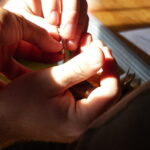
Tiny band with a number.
Banding is a traditional way of learning where birds go, habitat needs, and the impact of climate on both. Perhaps a fellow bander will catch “our” kinglet and inform scientists at the US Geological Survey.



























